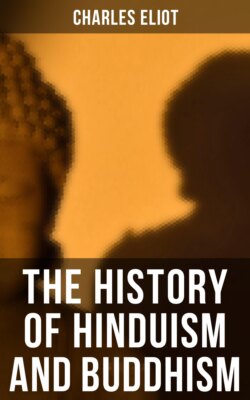Читать книгу The History of Hinduism and Buddhism - Charles Eliot - Страница 57
На сайте Литреса книга снята с продажи.
4
ОглавлениеThe Jains have a copious and in part ancient literature. The oldest works are found in the canon (or Siddhânta) of the Śvetâmbaras, which is not accepted by the Digambaras. In this canon the highest rank is given to eleven works[279] called Angas or limbs of the law but it also comprises many other esteemed treatises such as the Kalpasûtra ascribed to Bhadrabâhu. Fourteen older books called Puvvas (Sk. Pûrvas) and now lost are said to have together formed a twelfth anga. The language of the canon is a variety of Prakrit[280], fairly ancient though more modern than Pali, and remarkable for its habit of omitting or softening consonants coming between two vowels, e.g. sûyam for sûtram, loo for loko[281]. We cannot, however, conclude that it is the language in which the books were composed, for it is probable that the early Jains, rejecting Brahmanical notions of a revealed text, handed down their religious teaching in the vernacular and allowed its grammar and phonetics to follow the changes brought about by time. According to a tradition which probably contains elements of truth the first collection of sacred works was made about 200 years after Mahâvîra's death by a council which sat at Pataliputra. Just about the same time came the famine already mentioned and many Jains migrated to the south. When they returned they found that their co-religionists had abandoned the obligation of nakedness and they consequently refused to recognize their sacred books. The Śvetâmbara canon was subsequently revised and written down by a council held at Valabhi in Gujarat in the middle of the fifth century A.D. This is the edition which is still extant. The canon of the Digambaras, which is less well known, is said to be chiefly in Sanskrit and according to tradition was codified by Pushpadanta in the second century A.D. but appears to be really posterior to the Śvetâmbara scriptures[282]. It is divided into four sections called Vedas and treating respectively of history, cosmology, philosophy and rules of life[283].
Though the books of the Jain canon contain ancient matter, yet they seem, as compositions, considerably later than the older parts of the Buddhist Tripitaka. They do not claim to record recent events and teaching but are attempts at synthesis which assume that Jainism is well known and respected. In style they offer some resemblance to the Pitakas: there is the same inordinate love of repetition and in the more emotional passages great similarity of tone and metaphor[284].
Besides the two canons, the Jains have a considerable literature consisting both of commentaries and secular works. The most eminent of their authors is Hemacandra, born in 1088, who though a monk was an ornament of the court and rendered an important service to his sect by converting Kumârapâla, King of Gujarat. He composed numerous and valuable works on grammar, lexicography, poetics and ecclesiastical biography. Such subjects were congenial to the later Jain writers and they not only cultivated both Sanskrit and Prakrit but also had a vivifying effect on the vernaculars of southern India. Kanarese, Tamil, and Telugu in their literary form owe much to the labours of Jain monks, and the Jain works composed in these languages, such as the Jîvakacintâmaṇi in Tamil, if not of world-wide importance, at least greatly influenced Dravidian civilization.
Though the Jains thus occupy an honourable, and even distinguished place in the history of letters it must be confessed that it is hard to praise their older religious books. This literature is of considerable scientific interest for it contains many data about ancient India as yet unsifted but it is tedious in style and rarely elevated in sentiment. It has an arid extravagance, which merely piles one above the other interminable lists of names and computations of immensity in time and space. Even more than in the Buddhist suttas there is a tendency to repetition which offends our sense of proportion and though the main idea, to free the soul from the trammels of passion and matter, is not inferior to any of the religious themes of India, the treatment is not adequate to the subject and the counsels of perfection are smothered under a mass of minute precepts about the most unsavoury details of life and culminate in the recommendation of death by voluntary starvation.
